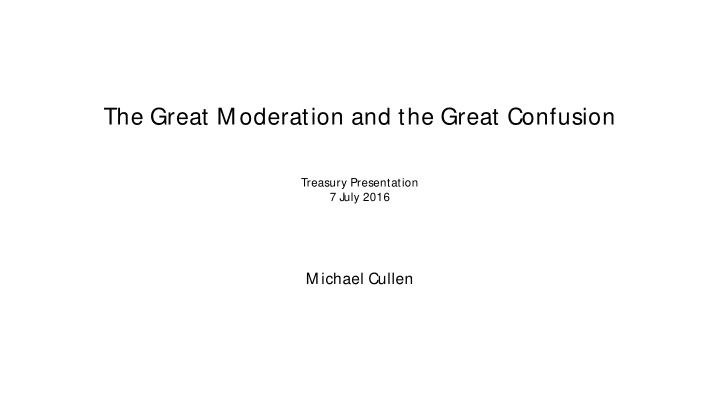



The Great M oderation and the Great Confusion Treasury Presentation 7 July 2016 M ichael Cullen
Pride The Great M oderation, c 1985-2007/8 • much reduced volatility in economic cycles • sustained period of relatively stable low inflation Attributed by many to successful innovation in monetary policy: • Inflation targeting • Central bank independence • Indicative interest rate setting • No impact on sustainable rate of growth
Is this all true? • other factors 1. shift from manufacturing to services 2. information 3. flexible labour markets • what was really targeted? • managing forward inflation expectations
Average growth not equal to sustainable rate • could be significantly lower • monetary policy could affect downwards, not upwards in small, open economy • sustainable growth rate not fixed
Fall • credit expansion • new instruments • classic financial collapse 2007-8 • followed by the Great Confusion
Responses • saving of financial system • monetary policy easing • quantitative easing • counterbalanced by fiscal austerity – especially in Europe • Europe now stuck in Japan-style low growth trap
Raises crucial questions • can equilibrating monetary and fiscal policy work in a full-scale financial crisis? • what are relative roles of monetary policy and fiscal policy in downturns? • what other approaches can be taken? 1. monetary policy tools 2. fiscal policy 3. tax 4. spending
Distinguish between ”normal “ cycles and financial crises. Normal business cycles: monetary policy most appropriate (agree with neo- Keynesian consensus). But still needs friends: • avoid contradictory fiscal policy • variable Kiwisaver contribution rate • flexibility • recognise effective lower band above zero
Financial crises • monetary policy quickly runs out of room • Need unorthodox monetary policy tools: 1. Q E 2. fiat money • Fiscal policy comes into play 1. Implies strong countercyclical fiscal policy on upside 2. Has to be able to be temporary and /or phaseable 3. Infrastructure 4. Housing (both requiring long term programmes) 5. Coordinated income policies possible?
Big Issues • fit for purpose financial system • serious commitment to balanced countercyclical fiscal policy • how to have “ projects in pocket” • direct fiscal injections need to be focused on lower paid • changes to welfare system • building a “ better globalisation” that manages change Summary: longer term, flexible thinking
Recommend
More recommend